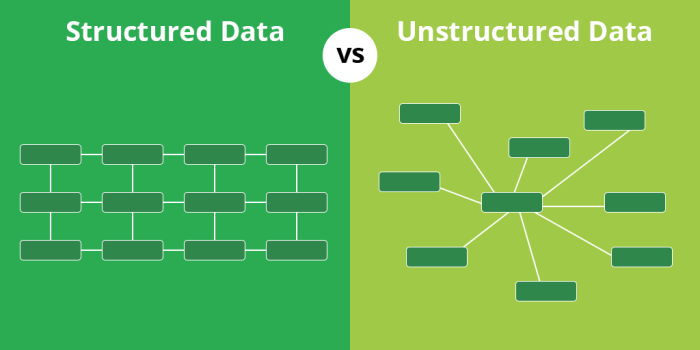What is the difference between structured and unstructured networking? This question unveils the complexities of network architectures, offering insights into their distinct characteristics, applications, and implications for the future of connectivity.
Structured networking, with its hierarchical organization, provides stability and predictability, while unstructured networking embraces flexibility and adaptability. As we delve into their applications, we discover the specific scenarios where each type shines.
Overview of Structured and Unstructured Networking

In the realm of networking, two distinct approaches emerge: structured and unstructured networking. Each method exhibits unique characteristics, advantages, and drawbacks, catering to different communication needs.
Structured networking adheres to a hierarchical organization, with predetermined roles and relationships. Think of it as a well-defined roadmap, guiding communication along established channels. Unstructured networking, on the other hand, thrives in a more fluid environment, allowing for spontaneous and informal connections.
Key Differences, What is the difference between structured and unstructured networking
- Hierarchy: Structured networks prioritize clear hierarchies, while unstructured networks foster a more egalitarian approach.
- Communication Channels: Structured networks rely on designated communication channels, while unstructured networks encourage communication through multiple channels.
- Flexibility: Structured networks offer less flexibility, whereas unstructured networks are highly adaptable to changing circumstances.
Examples
Structured Networking: Think of a traditional corporate organization chart, where employees communicate through specific channels, such as email or designated meetings.
Unstructured Networking: Picture a social gathering where individuals connect freely, exchanging ideas and building relationships in a spontaneous and informal manner.
Advantages and Disadvantages
Structured Networking:
- Advantages: Clear communication channels, enhanced coordination, increased efficiency.
- Disadvantages: Limited flexibility, potential for bottlenecks, reduced creativity.
Unstructured Networking:
- Advantages: Flexibility, adaptability, fostering innovation, encouraging collaboration.
- Disadvantages: Potential for confusion, difficulty in managing large networks, lack of accountability.
Applications of Structured and Unstructured Networking
Structured networking is often preferred in applications that require reliable and secure data transmission, such as:
– Financial transactions: Structured networking ensures the integrity and confidentiality of financial data during transactions, reducing the risk of fraud and data breaches.
– Enterprise resource planning (ERP) systems: Structured networking provides a reliable and secure foundation for ERP systems, which manage critical business processes such as supply chain management, inventory control, and customer relationship management.
– Cloud computing: Structured networking enables efficient and secure data transfer between on-premises and cloud-based applications, ensuring seamless integration and data accessibility.
Unstructured networking, on the other hand, is more suitable for applications that prioritize flexibility and adaptability, such as:
– Social media: Unstructured networking allows for the sharing of diverse content formats, including text, images, videos, and links, making it ideal for social interactions and community building.
– Internet of Things (IoT): Unstructured networking enables the seamless integration of a wide range of IoT devices, each with its unique data format and communication protocols.
– Big data analytics: Unstructured networking facilitates the collection and analysis of large volumes of unstructured data, such as sensor data, social media feeds, and web logs, enabling organizations to extract valuable insights and make informed decisions.
Implementation Considerations

When implementing structured networking, a formal and hierarchical approach is adopted, with clearly defined roles and responsibilities for each node in the network. Nodes are organized into a tree-like structure, with a central authority figure or root node managing the flow of information and resources. This centralized control allows for efficient management and coordination of network activities, ensuring that all nodes adhere to established protocols and standards.
In contrast, unstructured networking is characterized by a decentralized and peer-to-peer approach, where all nodes have equal status and responsibilities. There is no central authority figure, and nodes interact directly with each other to exchange information and resources. This decentralized nature promotes flexibility and adaptability, allowing the network to respond quickly to changes in the environment.
Challenges and Best Practices
When implementing structured networking, one of the main challenges lies in maintaining the hierarchical structure and ensuring that all nodes comply with established protocols. To address this, it is essential to implement robust mechanisms for node authentication, authorization, and access control. Additionally, regular monitoring and maintenance are crucial to ensure that the network remains stable and secure.
In unstructured networking, the primary challenge stems from the lack of central control, which can lead to inconsistencies in data and resource management. To mitigate this, it is important to establish clear guidelines and protocols for node interaction, ensuring that all nodes adhere to common standards and best practices. Additionally, implementing mechanisms for data validation and verification can help ensure the integrity and reliability of information shared within the network.
Comparison of Structured and Unstructured Networking

Structured and unstructured networking exhibit distinct characteristics, offering advantages and limitations in various scenarios. The following table provides a comprehensive comparison to highlight these differences:
| Feature | Structured Networking | Unstructured Networking |
|---|---|---|
| Data Format | Well-defined, hierarchical structure | No predefined structure or hierarchy |
| Data Access | Faster and more efficient due to predefined structure | Slower and less efficient due to lack of structure |
| Scalability | Limited scalability due to rigid structure | Highly scalable due to flexible structure |
| Flexibility | Less flexible due to predefined structure | More flexible due to lack of structure |
| Security | Enhanced security due to structured data and defined access controls | Reduced security due to unstructured data and lack of defined access controls |
| Applications | Databases, spreadsheets, relational databases | Social media, collaboration platforms, knowledge management systems |
The choice between structured and unstructured networking depends on the specific requirements of the application. Structured networking is ideal for scenarios where data organization, efficient access, and security are paramount. On the other hand, unstructured networking is suitable for applications that prioritize flexibility, scalability, and handling diverse data formats.
Emerging Trends in Networking
The networking landscape is constantly evolving, with new technologies and trends emerging all the time. Structured and unstructured networking are both experiencing significant changes, and these trends are expected to have a major impact on the future of networking.
Emerging Trends in Structured Networking
Some of the most notable emerging trends in structured networking include:
- The increasing adoption of software-defined networking (SDN)
- The growing popularity of cloud-based networking services
- The emergence of new networking technologies, such as 5G and Wi-Fi 6
These trends are making structured networking more flexible, scalable, and cost-effective. As a result, structured networking is becoming increasingly popular for a wide range of applications, from enterprise data centers to small businesses.
Emerging Trends in Unstructured Networking
The most notable emerging trends in unstructured networking include:
- The growth of the Internet of Things (IoT)
- The increasing use of social media and other online collaboration tools
- The emergence of new technologies, such as blockchain and artificial intelligence (AI)
These trends are making unstructured networking more complex and challenging to manage. However, they are also creating new opportunities for innovation and collaboration. As a result, unstructured networking is becoming increasingly important for a wide range of applications, from social networking to e-commerce.
Impact on the Future of Networking
The emerging trends in structured and unstructured networking are expected to have a major impact on the future of networking. These trends will make networks more flexible, scalable, and cost-effective. They will also create new opportunities for innovation and collaboration. As a result, networking will become increasingly important for a wide range of applications, from enterprise data centers to social networking.
Last Point: What Is The Difference Between Structured And Unstructured Networking
The choice between structured and unstructured networking hinges on the specific requirements of the application. Structured networking excels in environments demanding reliability and control, while unstructured networking thrives in dynamic, rapidly evolving scenarios. As networking technologies continue to advance, hybrid approaches that blend the strengths of both architectures are likely to emerge, shaping the future of connectivity.
Frequently Asked Questions
What is the key difference between structured and unstructured networking?
Structured networking follows a hierarchical organization with defined rules and protocols, while unstructured networking is more flexible and adaptable, allowing for dynamic connections.
Which type of networking is better for large-scale enterprise networks?
Structured networking is typically preferred for large-scale enterprise networks due to its stability and predictability.
What are the advantages of unstructured networking?
Unstructured networking offers flexibility, scalability, and the ability to accommodate rapid changes in network topology.













